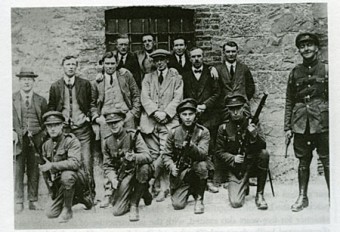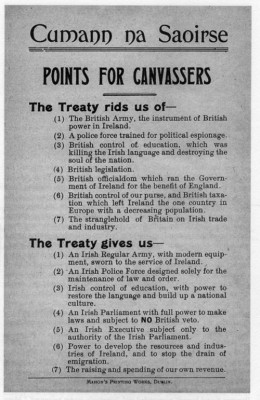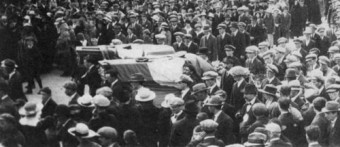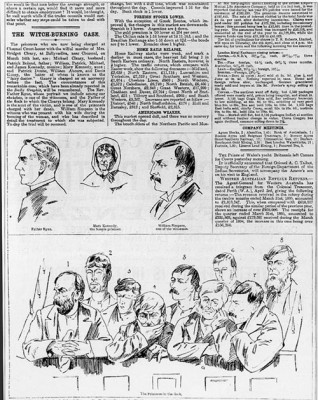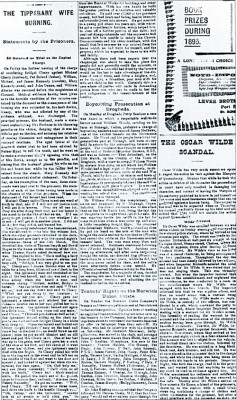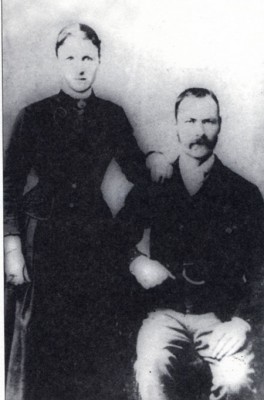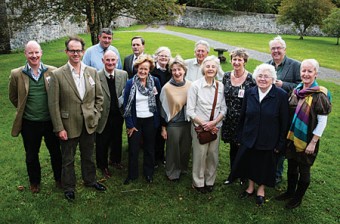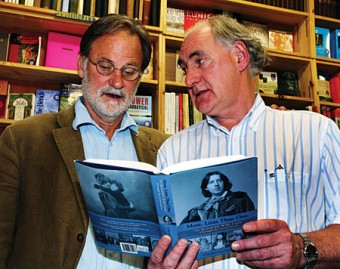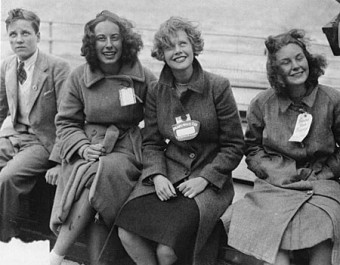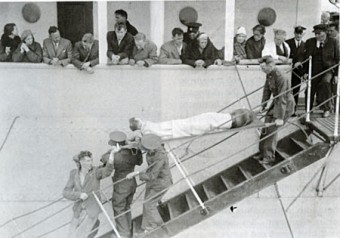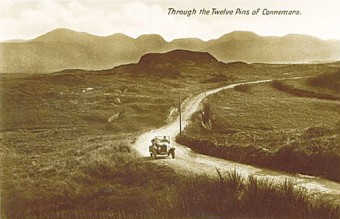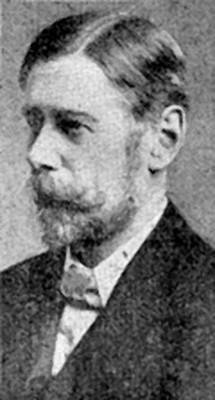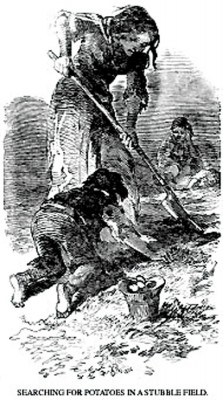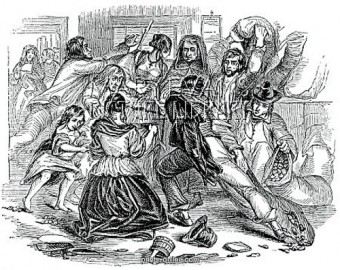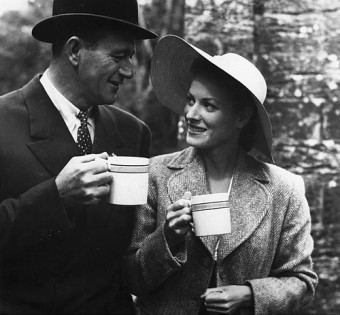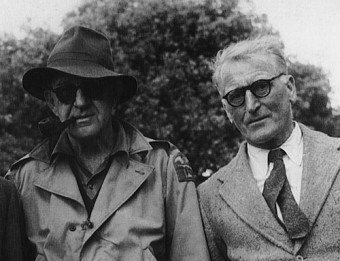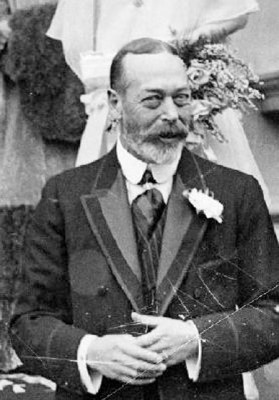Europe never tasted so good
Thu, Dec 01, 2011
I am glad Galway does not have Michelin starred restaurants. I have eaten in two Dublin restaurants when the family occasion, so I was told, warranted a Michelin starred meal. The first occasion was very good. The owner/chef visited all the tables and chatted pleasantly, hoping that we had enjoyed our meal. We all had. On the following two occasions, including another restaurant, which to my disbelief, retained its Michelin star this year, both meals were a disgrace. Incredibly over priced, snobby and condescending waiters, tiny portions, and pretentious food. Apart from the obligatory ‘is everything all right?’ no sincere effort was made to connect with the customer.
Read more ...Firing squads bring Civil War to a close
Thu, Nov 24, 2011
The Civil War in Galway came to an end because there was little appetite for further bloodshed in the face of ruthless determination by the Free State, or the pro-treatyites, to stamp out the anti-treaty forces. The Free State government warned that anyone carrying weapons other than the National Army, would be shot. Eleven Galway anti-treatyites were shot by firing squad. On January 20 1923 Martin Bourke, Stephen Joyce, Herbert Collins, Michael Walsh, and Thomas Hughes, all attached to the North Galway IRA Brigade, were arrested and executed in Athlone. On February 19 eighteen volunteers were arrested in Annaghdown, and brought to Galway gaol. It was given out that all were ‘well armed’. Even though it was expected that all, or a number of them, would be shot, nothing happened.
Read more ...Civil War - British gunboat sent to Clifden
Thu, Nov 17, 2011
June 22 1922 Galwegians looked on with alarm as anti-Treaty forces, who had taken up positions in a number of buildings in the city, including the former RIC station at Eglinton Street, were preparing for a fight. That morning Michael Brennan, IRA commander of the only major pro-Treaty unit in the west, under orders from Richard Mulcahy Free State Army commander, entered the city with a large well armed force. They immediately secured the county-jail, the courthouse, and the railway hotel. Having seen the end of the War of Independence, and having voted by a substantial majority just weeks before for parties supporting the Treaty with Britain, this was a tragic state of affairs. Galwegians feared an all out pitched battle, followed by the horrors of the previous years of struggle. This time, however, the enemy was not Britain, but former friends and comrades.
Read more ...Galway 1910 - 1923, the changing years
Thu, Nov 10, 2011
Early in 1916, Pádraic Pearse visited Athenry to discuss plans for the Rising. He wanted the Volunteers to hold the county at the River Suck at Ballinasloe, to capture Galway city, and then, if possible, to march on Dublin. There were several variations of this strategy, but whichever plan was finally agreed, its success depended on the Volunteers receiving modern weaponry. Up to then the men had been rehearsing with shotguns, and sticks. Pearse assured them that small arms, including assault rifles and machine guns, were on their way. They would arrive in Gort, and be distributed from there.
Read more ...‘A degree of darkness in the mind’
Thu, Nov 03, 2011
Remarkably, and that is a word already used in this drama, the court accepted Michael Cleary’s plea of manslaughter. He was charged with the murder of his wife Bridget by burning her to death, but the jury accepted that Cleary had really believed that his wife had been transformed into a ‘changeling’ by the fairies; and it was only a concoction of herbs and fire that would release her from its spell.
Read more ...The ‘savage’ Irish peasant unfit for Home Rule
Thu, Oct 27, 2011
During the 1880s and ‘90s a series of Land Acts gradually diffused the sometimes bitter animosity that had grown between landlord and tenant. Over the years new and imaginative legislation dramatically improved the status of the tenant. Improvements for the tenant, however, were gained at the disadvantage of the landlord class. In many cases the Unionist landlord vigorously resisted change. During this bitter time landlords and their agents were murdered, animals were maimed and let loose to wander; there was ‘boycotting’, and heartless evictions. Practically every town and village had its RIC station. These were the eyes and ears of Dublin Castle. Any suspect person, or any unusual activity, was reported. On April 6 1895 RIC district inspector in Kilkenny, Pierris B Pattison, sent a report to Dublin Castle, with photographs, on a case ‘that is remarkable’ and which has caused ‘much public interest and local excitement.’
Read more ...‘Amongst Hottentots one would not expect to hear of such an occurrence’
Thu, Oct 20, 2011
When the Kilkenny essayist Herbert Butler came to write about the burning of Bridget Cleary in 1960 he acknowledged that Slievenaman was always known for its mysterious past. Looking across the Tipperary border from his fields, he described it as ‘a pale blue hump with the soft, rounded contours of ancient hills whose roughness have been smoothed away by time. Finn MacCool lived there as did Oisin and Oscar, and 50 beautiful maidens, who gave it its name The Mountain of Women.’ In Bridget Cleary’s time, it was also the home of Denis Ganey, the local herbal doctor, and a man respected and feared for his knowledge of fairylore. It was to this house that Michael Cleary ran to on the afternoon of Thursday March 14 1895. He pleaded for a cure for his wife whom he believed had been taken by the fairies, and replaced by a woman that was not the Bridget Boland he had married.
When he returned to his cottage at Ballyvadlea, with the hill of Tullowcossaun behind it, the house was full of people along with his sick wife. There was her father Patrick Boland, her aunt Mary Kennedy; her four cousins Patrick, Michael, James, and William Kennedy, William Aherne, and the man who first pronounced that Bridget was a fairy ‘changeling’, Jack Dunne.
Read more ...‘That is not Bridgie Boland!’
Thu, Oct 13, 2011
On Monday March 4 1895, Bridget Cleary, walked up a hill to Kylenagranagh, the home of her father’s cousin Jack Dunne, who lived with his wife Kate, to sell eggs. The Dunne’s house, less than two miles from her slate-roofed labourer’s cottage at Ballyvadlea, Co Tipperary, was near an ancient circular mound of earth, or a ring fort, still known in rural Ireland as a ‘fairy fort’. Maybe it was because of the location of his house, or because of his skill as a story teller, a ‘Shanachie’, and that he had a limp, that Dunne had the reputation for being ‘an old man who is fairy-ridden’. People believed the local legend that he was once ‘chased up to his home by a man in black, and a woman in white’. He had knowledge of incantations, charms, and spells, and was sometimes consulted for a cure for animal or female sicknesses.
Read more ...Has Sir William Gregory been brought in from the cold?
Thu, Sep 29, 2011
Sir William Gregory of Coole, Co Galway, and the husband of Lady Augusta in his later years, has been vilified unfairly by historians and commentators, said Brian Walker, professor of Irish Studies at Queen’s University last weekend. As the member of parliament who introduced the so called ‘Gregory clause’ as the Great Famine raged through the land, he did so for humane motives; but it was exploited by some ruthless landlords to clear their land.
Read more ...‘Lady Betty’ and the ‘ enemy of romance’
Thu, Sep 22, 2011
In the 1820s the hangman for the Connacht circuit was a woman known as ‘Lady Betty’. She had actually been sentenced to death for killing her own son, and stealing his savings. But she escaped the hangman’s noose by pleading that she could fill the vacancy that existed for a hangman. Her first hanging was watched to see if she could handle the rough business of a public execution with some sort of expediency. Apparently she could. She was officially appointed to hang and flog those convicted in the Connacht courts.
Read more ...Galway’s ‘splendid human spirit’
Thu, Sep 08, 2011
The people of Galway were shocked and excited by the arrival of 430 survivors who were brought ashore from the Athenia which was sunk by torpedo off the Donegal coast only hours after war was declared on September 3 1939. The town was galvanised into action. An impressive and practical plan was put into place to receive the survivors, to ensure they were comfortably accommodated, and to care for the wounded. There were 10 stretcher cases, numerous minor injuries, and distressed children. The passengers, who included Americans and Canadians, and refugees fleeing a deteriorating political situation in Europe, were bound for Montreal.
Read more ...The day war came to Galway
Thu, Sep 01, 2011
On Monday morning September 4 1939, the Galway harbour master Capt T Tierney was listening to a radio message from the Norwegian freighter Knute Nelson to say that it was steaming to Galway with 430 survivors from the Athenia, which was sunk by torpedo 250 miles north-west of Inishtrahull Island, off the Donegal coast. There were injuries among the survivors. Many were distressed and suffering from hypothermia. It requested urgent assistance.
Read more ...Teaching Irish in Connemara 1907
Thu, Aug 18, 2011
It may sound like a contradiction of terms, but teaching the Irish language in the opening decades of the last century could also be a method of teaching English. Irish was the spoken language in most homes of the west of Ireland, but it was recognised that knowledge of English was essential when emigration was usually the only way a young man or girl could better themselves. It is to the great credit of the Gaelic League, established in 1893 to promote the teaching of Irish in all national schools, that it recognised that fact. The Gaelic League, like its near contemporary the GAA, idealised the culture and way of life of the surviving Gaeltacht areas; and its success was largely due to its understanding that a bilingual approach would best serve everyone’s purposes.
Read more ...What hope has a kitten in a town full of dogs?
Thu, Jul 14, 2011
There were disturbing echoes of the Imelda Riney murders in a wood near Whitegate, Co Clare, in April 17 years ago, in Enda Walsh’s new play Misterman, which opened this years Arts Festival on Monday. Imelda and her young four-years -old son and a priest were shot by Brendan O’Donnell, who later killed himself in prison. Woods are beautiful in springtime, but since our childhood fairy tales have told us that woods can be sinister places. In a superb piece of stage business Thomas Magill leads his angelic Edel into the woods along a green carpet which rolls out ahead of them, leading to the river where they sit. We don’t hear of Edel’s fate till the last moments of the play, but we have our suspicions.
Read more ...Hundreds of thousands starved while the sea teemed with fish
Thu, Jun 23, 2011
Reading William Henry’s book Famine - Galway’s Darkest Days*, I was struck yet again by the fact that while thousands of people died of starvation in the west of Ireland, when whole communities abandoned their homes in a desperate search for food, our seas were boiling with fish. The author tells us that in Galway at the beginning of the Great Famine in 1845 the Claddagh fishermen fiercely protected their fishing rights in the Bay, which they regarded as their exclusive property. But as the famine dragged on to the end of the decade the Claddagh fishermen had no means left for catching fish. They had pawned their boats and fishing equipment for food. The historian Cecil Woodham-Smith in her classic account of the Great Famine**, tells us that on January 9 1847, ‘all boats were drawn up to the quay wall, stripped to the bare poles, not a sign of tackle or sail remaining....not a fish was to be had in the town, not a boat was at sea.’
Read more ...Mary Kate Danaher: ‘ I feel the same way about it myself’...
Thu, Jun 16, 2011
At last filming The Quiet Man began in June 1951, during one of the sunniest summers on record. Everything went smoothly. There was a genuine outpouring of goodwill from the people of Cong and everywhere in Ireland, towards the project. The crew and cast were happy. The actors were generous with signing autographs, making guest appearances at charity events, and had an excellent working relationship with the director John Ford. Ford was in wonderful good form. He had exorcised his war ghosts by making an astonishing 10 movies in only six years. Now he was relaxed and cheerful, beaming to be in Ireland with great actors, many of whom were his friends, and a script which he clearly liked. He had already worked out changes which he had discussed with his friend and adviser Brian Desmond Hurst in their rented house in Spiddal.
Read more ...We can be proud of our military heritage
Thu, May 26, 2011
On June 12 1922 a very special ceremony took place at Windsor Castle, near London. Following the establishment of the Irish Free State the previous December, five Irish regiments, including the Connaught Rangers, the Royal Irish, the Leinsters, the Munsters, and the Dublin Fusiliers, which had served the British army with exceptional valour at times, were disbanded. It was a day of special significance for both the participants and onlookers. It was reported in the London Times.
Read more ...
